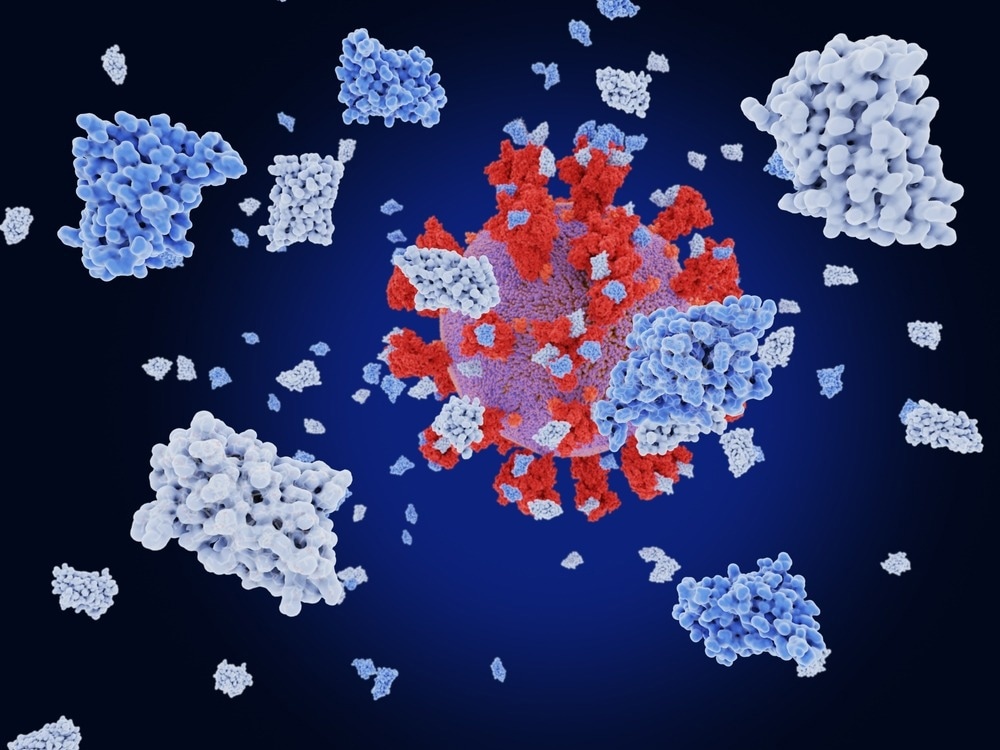In a recent study published in iScience, researchers engineered biparatopic nanobodies against severe acute respiratory syndrome coronavirus 2 (SARS-CoV-2).
 Study: Biparatopic nanobodies targeting the receptor binding domain efficiently neutralise SARS-CoV-2. Image Credit: Juan Gaertner/Shutterstock
Study: Biparatopic nanobodies targeting the receptor binding domain efficiently neutralise SARS-CoV-2. Image Credit: Juan Gaertner/Shutterstock
Background
Despite the rapid development of effective and safe vaccines against SARS-CoV-2, questions regarding their long-term efficacy prevail, warranting the continued search for new therapeutic strategies. Recombinant protein biologics such as monoclonal antibodies (mAbs) hold potential for prophylaxis and treatment of infected individuals.
Further, nanobodies, antibodies containing a single variable domain, are native to the camelid family. The small size, high stability, and simple architecture of nanobodies are beneficial over conventional mAbs. These allow enhanced penetration into tissues, with a propensity for high-affinity binding to small epitopes. Moreover, nanobodies are amenable to covalent linkages for function enhancement and typically have higher yields and lower production costs.
The study and findings
In the present study, researchers isolated nanobodies against the SARS-CoV-2 spike’s receptor-binding domain (RBD) using a synthetic yeast display library. RBDs were engineered in two formats – 1) RBD monomer with an AVI-tag for biotinylation and 2) dimeric RBD-Fc, in which the RBD was fused with the fragment crystallizable (Fc) domain of mouse IgG1.
The RBD probes were validated by transiently transfecting 293T cells with human angiotensin-converting enzyme 2 (hACE2) and stained with tetramerized RBD monomers. The authors noted an ACE2-dependent binding of RBD probes to 293T cells, validating their functional integrity. These tetramers were used for generating RBD-specific neutralizing nanobodies from a yeast display library.
The selection involved two successive magnetic enrichment steps, followed by fluorescence-activated cell sorting (FACS)-based enrichment, which resulted in a library with approximately 72% of RBD-binding yeast clones. Next, the library was co-stained with RBD tetramers from SARS-CoV-1 and SARS-CoV-2, which revealed distinct populations.
One population (major) bound SARS-CoV-2 RBD tetramers exclusively, whereas the other (minor) population bound RBD tetramers from both viruses. Likely, the SARS-CoV-1/2 cross-reactive clones might have a conserved RBD epitope, representing an important target. Next, the clones were single-cell sorted, and the top 10 clones with the brightest RBD tetramer staining were sequenced.
Mammalian expression vectors were cloned with the DNA of RBD-specific nanobodies, and the nanobodies were purified. The authors tested if the purified nanobodies inhibited ACE2-RBD interaction using a surrogate virus neutralization test (sVNT) and found four nanobody clones (A11, B1, C8, and G8) that inhibited binding. Of note, only G8 nanobody was SARS-CoV-1/2 cross-reactive.
The RBD-binding capacity of the nanobody clones was assessed using surface plasmon resonance (SPR). The four nanobodies bound SARS-CoV-2 RBD with moderate affinities, while only G8 bound the SARS-CoV-1 RBD, albeit with a reduced affinity. Further SPR-based experiments revealed two distinct modes of binding – one involved binding to a shared epitope (for A11, B1, and C8 constructs) and the other to a different epitope (G8) that was more conserved within the SARS-CoV-1 RBD.
Although the nanobodies exhibited moderate affinities, they were unlikely to strongly neutralize infection compared to the multiple high-affinity mAbs in use. Therefore, the researchers generated a series of nanobody constructs to augment the neutralization capacity of nanobody monomers. The nanobody clones with the highest affinities (G8 and B1) were used. These enhancement experiments involved three different strategies.
First, a human IgG1 Fc domain was fused to the nanobodies (B1-Fc and G8-Fc constructs). Second, B1 and G8 were covalently joined (biparatopic constructs) via a glycine-serine (GS) linker. The biparatopic (BP) constructs were generated with three different linker lengths (10, 19, and 39 amino acids). Third, dimeric biparatopic constructs were generated using human IgG1 Fc domains. A microneutralization assay was performed to test if the constructs inhibited SARS-CoV-2 infection.
As monomers, B1 and G8 moderately inhibited infection; however, Fc dimerization of either nanobody improved their neutralizing activity. Notably, the monomeric biparatopic constructs markedly enhanced neutralization, increasing with linker length. Fc dimerization of biparatopic constructs resulted in potent neutralizing activity; however, they were less effective than their monomeric counterparts.
Furthermore, the biparatopic nanobodies were tested using a multiplex RBD variant array to assess their ability to overcome viral escape. Nanobody binding to RBDs from SARS-CoV-2 variants of concern (VOCs) and RBD-ACE2 inhibition was measured. The G8-Fc construct bound to all tested variants with high potency, but the B1-Fc nanobody showed reduced binding to Beta and Gamma variant RBDs and those containing E484D, E484K, Q493K, and S494P substitutions.
Nevertheless, the biparatopic nanobody with a 10-amino acid linker (BP10) had a similar profile as G8-Fc. The RBD-ACE2 interaction inhibition was tested in a bead-based sVNT using 20 distinct RBDs, including those from SARS-CoV-1, bat and pangolin coronaviruses, and the Omicron BA.1 and BA.2 variants.
The findings were similar to those from the multiplex array. However, the nanobody constructs did not neutralize the Omicron variants. Lastly, mice were separately treated with B1-Fc, G8-Fc, and BP10-Fc constructs and challenged with SARS-CoV-2 after 24 hours. G8-Fc treatment moderately decreased viral loads in the lungs. In contrast, mice treated with B1-Fc or BP10-Fc were fully protected.
Conclusions
In summary, the study demonstrated the isolation of SARS-CoV-2-neutralizing nanobodies using a yeast display library and that generation of biparatopic nanobodies could improve their neutralizing potency, apparently due to the cross-linking of distinct spike proteins. Intriguingly, the dimerization of the biparatopic constructs failed to enhance neutralization relative to their monomeric counterparts.